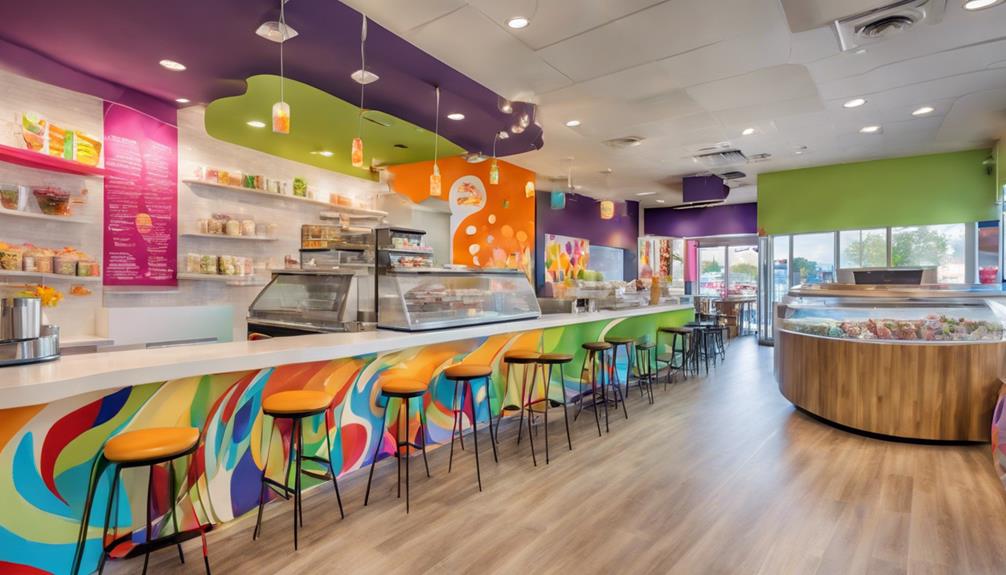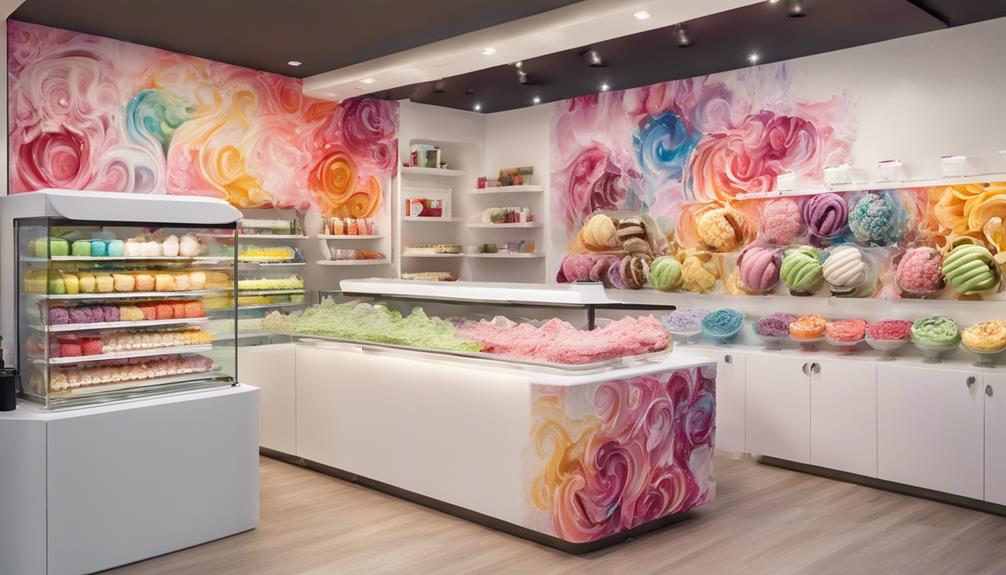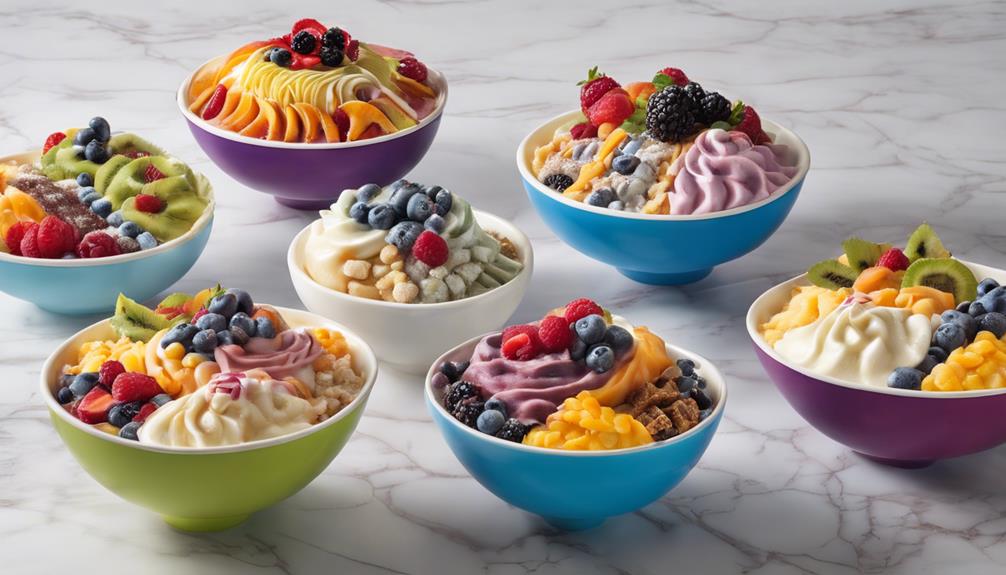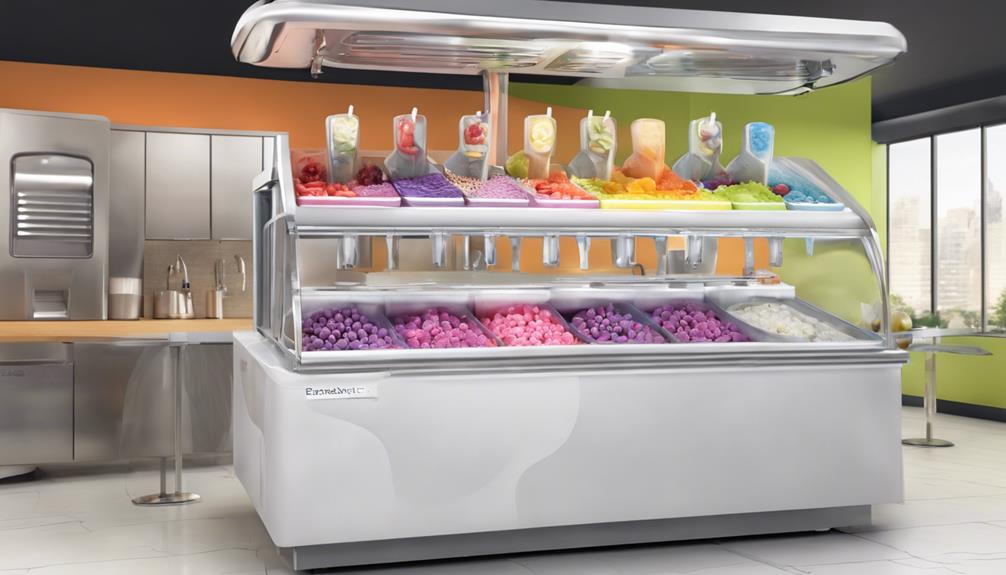When you think about frozen yogurt, you probably imagine it as a simple dessert, but it's much more than that. Its journey from a niche health food to a global sensation reveals fascinating intersections of culture and culinary innovation. Have you ever considered how the flavors and toppings you enjoy are influenced by regional tastes and traditions? From Italian gelato-style yogurt to Japan's matcha-infused versions, each country brings its own twist, making frozen yogurt a canvas for cultural expression. So, what does your favorite frozen yogurt flavor say about the world around you? You might find the answer intriguing.
Key Takeaways
- Frozen yogurt reflects a global shift towards healthier eating habits and dessert choices.
- Celebrity endorsements and pop culture appearances boost frozen yogurt's trendy status.
- Self-serve shops cater to personalized preferences, mirroring consumer demand for customization.
- Diverse flavors and local ingredients showcase cultural influences and regional tastes.
- Frozen yogurt's popularity highlights the fusion of culinary innovation and health-conscious living.
History of Frozen Yogurt

The history of frozen yogurt, affectionately called FroYo, began in the 1970s and represents a significant cultural shift towards healthier dessert options in the United States. This era marked a notable change in consumer preferences, driven by an increasing awareness of health and nutrition. Frozen yogurt emerged as a nutritious dessert alternative to traditional ice cream, capturing the attention of those seeking to indulge without compromising their health goals.
Companies like H.P. Hood were pivotal in shaping the yogurt industry. They recognized the growing demand for healthier dessert options and capitalized on it by promoting frozen yogurt's health benefits. Unlike traditional ice cream, FroYo was marketed as a versatile dessert option that could be enjoyed guilt-free.
Initially, frozen yogurt flavors were quite basic, mirroring those found in traditional ice cream. However, as consumer attitudes evolved, so did the diversity of flavors. The yogurt industry responded by offering an array of innovative and diverse flavors, catering to varying tastes and preferences. This evolution not only broadened FroYo's appeal but also solidified its place as a staple in the dessert market, reflecting a broader cultural shift towards health-conscious eating habits.
Health Benefits
In recognizing the growing trend towards healthier eating habits, frozen yogurt stands out for its lower calorie content and beneficial probiotics, making it a preferred choice over traditional ice cream. This shift reflects an increasing awareness of health benefits and a desire to incorporate nutrient-rich foods into daily life.
Frozen yogurt is packed with essential nutrients like protein and calcium, which are crucial for maintaining strong bones and teeth. The inclusion of beneficial probiotics in frozen yogurt aids in promoting gut health, contributing to a balanced digestive system. These probiotics are known to support overall well-being by enhancing nutrient absorption and boosting the immune system.
Culturally, the rise of frozen yogurt aligns with a broader move towards accommodating diverse dietary needs. You'll find a variety of options, including non-dairy and sugar-free frozen yogurt, catering to vegans, those with lactose intolerance, and individuals seeking to reduce sugar intake. This adaptability makes it a versatile dessert choice in today's health-conscious society.
Historically, the emphasis on lower calorie content and nutrient density has resonated with consumers aiming to lead healthier lifestyles. Frozen yogurt's combination of taste and health benefits continues to secure its place as a favored treat across generations.
Rise of Frozen Yogurt Shops

You might've noticed that frozen yogurt shops have become ubiquitous, reflecting a cultural shift towards healthier dessert options and a demand for personalized, self-serve experiences. This rise is largely driven by consumer preferences for treats that are both delicious and health-conscious. The self-serve model, where you can customize your yogurt with a variety of flavors and toppings, caters perfectly to today's desire for personalization and convenience.
Historically, frozen yogurt shops gained popularity in the US, where the wide variety of flavors and larger portions struck a chord with consumers. This trend quickly spread globally, adapting to local tastes and cultural influences. For instance, in some regions, you might find unique combinations that incorporate local ingredients or traditional flavors, blending modern dessert trends with cultural heritage.
The global consumer has embraced frozen yogurt, integrating it into various cuisines and celebrations, thereby contributing to its worldwide popularity. The ability to create unique combinations of flavors and toppings has made frozen yogurt shops a hit among diverse populations. As a result, the frozen yogurt phenomenon underscores a broader cultural movement towards health-conscious living and culinary innovation.
Frozen Yogurt in Pop Culture
As frozen yogurt shops have become essential to the global dessert landscape, their influence has permeated pop culture, with movies, TV shows, and celebrities amplifying its trendy image. This fashionable dessert choice often appears in popular media, solidifying its stylish reputation. You've likely seen characters indulging in frozen yogurt in beloved TV series like 'Friends' or 'The Big Bang Theory,' where it's portrayed as a go-to treat. Such portrayals have contributed greatly to its cultural influence.
Celebrity endorsements have played an important role in boosting frozen yogurt's appeal. Stars like Jennifer Lopez and Justin Bieber have been spotted enjoying this trendy dessert, making it even more desirable. When Oprah Winfrey and Lady Gaga share their love for frozen yogurt, it sparks widespread interest and elevates its status as a stylish dessert. These endorsements don't just increase sales but also shape public perception, making frozen yogurt a symbol of modern, chic living.
The evolution of flavors and toppings has further diversified frozen yogurt's appeal, catering to diverse tastes and reflecting popular culture influence. This ongoing innovation ensures that frozen yogurt remains relevant and exciting in the ever-evolving food landscape.
Evolution of Flavors

From licorice-infused options in Denmark to durian flavors in Southeast Asia, the evolution of frozen yogurt flavors showcases a rich tapestry of cultural influences and local tastes. This global trend underscores how local ingredients and unique flavor combinations shape the offerings in frozen yogurt shops worldwide.
In the United States, diverse flavor preferences reflect the melting pot of cultures, leading to an ever-expanding menu that includes everything from traditional vanilla to exotic matcha. Italy's expertise perception in gelato translates into yogurt gelato in soft serve form, seamlessly blending their rich heritage with modern trends. Meanwhile, Greece's historical connection to yogurt is evident in their Greek-made frozen yogurt, which has gained international acclaim.
Countries like Singapore, Japan, and Hong Kong take it a step further by crafting elaborate parfaits that not only highlight their cultural influences but also elevate the dessert experience. These parfaits often incorporate:
- Local fruits and nuts: enhancing the authenticity of flavors.
- Artistic presentations: appealing to both taste and aesthetics.
- Traditional ingredients: offering a taste of heritage.
- Innovative toppings: providing a modern twist.
The evolution of flavors in frozen yogurt is a reflection of the diverse flavor preferences and the rich interplay of cultural influences, making each scoop a journey through a different part of the world.
Frequently Asked Questions
Does Frozen Yogurt Have Culture?
You're wondering if frozen yogurt has culture. It does, through flavor trends, toppings variety, health benefits, global popularity, dessert hybrids, seasonal offerings, custom creations, brand loyalty, social media, and cultural symbolism, all blending into a rich, historical tapestry.
What Is the Demographic of Frozen Yogurt?
Imagine a rainbow of age groups enjoying frozen yogurt. It captivates young adults, appeals to health trends, and fits diverse eating habits. Geographic distribution targets urban areas, while family demographics and seasonal sales shape its market segmentation.
What's the Point of Frozen Yogurt?
You'll find frozen yogurt's point lies in its health benefits, like aiding weight management and offering dessert alternatives. With diverse flavor options, nutritional value, probiotic content, low calorie, sugar-free choices, and accommodating lactose intolerance, it's unbeatable.
Where Did Frozen Yogurt Originate?
Frozen yogurt originated in the US during the 1970s, blending Greek yogurt with elements of ice cream. It catered to lactose intolerance, offered probiotic benefits, lower calorie count, and diverse flavors, topping the dessert trends with health benefits.
Conclusion
You've now seen how frozen yogurt has evolved from a simple dessert to a cultural phenomenon. Did you know that over 50% of frozen yogurt shops worldwide incorporate local ingredients unique to their region? This statistic isn't just a number; it's a demonstration of the global embrace of cultural diversity. As you savor your next cup, remember, you're not just enjoying a treat, but also experiencing a rich blend of history, culture, and culinary innovation.







